Rectifiers’ Design and Optimization for a Dual-Channel RF Energy Harvester
Abstract
1. Introduction
2. Design Method and Optimization
3. Simulations and Experimental Results
4. Conclusions
Author Contributions
Funding
Acknowledgments
Conflicts of Interest
References
- De Rubeis, T.; Nardi, I.; Muttillo, M.; Ranieri, S.; Ambrosini, D. Room and window geometry influence for daylight harvesting maximization—Effects on energy savings in an academic classroom. Energy Proc. 2018, 148, 1090–1097. [Google Scholar] [CrossRef]
- Pantoli, L.; Muttillo, M.; Stornelli, V.; Ferri, G.; Gabriele, T. A Low Cost Flexible Power Line Communication System. In Lecture Notes in Electrical Engineering; Springer: Cham, Switzerland, 2017; pp. 413–420. [Google Scholar]
- Barile, G.; Leoni, A.; Pantoli, L.; Stornelli, V. Real-Time Autonomous System for Structural and Environmental Monitoring of Dynamic Events. Electronics 2018, 7, 420. [Google Scholar] [CrossRef]
- Barile, G.; Leoni, A.; Pantoli, L.; Safari, L.; Stornelli, V. A New VCII Based Low-Power Low-Voltage Front-end for Silicon Photomultipliers. In Proceedings of the 2018 3rd International Conference on Smart and Sustainable Technologies (SpliTech), Split, Croatia, 26–29 June 2018; ISBN: 978-953290083-5. [Google Scholar]
- Leoni, A.; Pantoli, L.; Stornelli, V.; Ferri, G.; Šolić, P.; Russo, M. A combined 90/900 MHz IC architecture for power-assisting in IoT applications. J. Commun. Softw. Syst. 2018, 14, 27–32. [Google Scholar]
- Gabriele, T.; Pantoli, L.; Stornelli, V.; Chiulli, D.; Muttillo, M. Smart power management system for home appliances and wellness based on wireless sensors network and mobile technology. In Proceedings of the AISEM, Trento, Italy, 3–5 February 2015. [Google Scholar]
- Pantoli, L.; Leoni, A.; Stornelli, V.; Ferri, G. An IC architecture for RF Energy Harvesting systems. J. Commun. Softw. Syst 2017, 13, 96. [Google Scholar] [CrossRef]
- Al Agha, K.; Bertin, M.; Dang, T.; Guitton, A.; Minet, P.; Val, T.; Viollet, J. Which Wireless Technology for Industrial Wireless Sensor Networks? The Development of OCARI Technology. IEEE Trans. Ind. Electron. 2009, 56, 4266–4278. [Google Scholar] [CrossRef]
- Xiao, H.; Shao, H.; Yang, K.; Yang, F.; Wang, W. Multiple Timescale Energy Scheduling for Wireless Communication with Energy Harvesting Devices. Radioeng. J. 2012, 21, 3. [Google Scholar]
- Gutierrez, M.; Shahidi, A.; Berdy, D.; Peroulis, D. Design and characterization of a low frequency 2-dimensional magnetic levitation kinetic energy harvester. Sens. Actuators A Phys. 2015, 236, 1–10. [Google Scholar] [CrossRef]
- Gleonec, P.D.; Ardouin, J.; Gautier, M.; Berder, O. Architecture exploration of multi-source energy harvester for IoT nodes. In Proceedings of the IEEE Online Conference on Green Communications (OnlineGreenComm), Piscataway, NJ, USA, 14–17 November 2016; pp. 27–32. [Google Scholar]
- Shi, J.J.; Huang, X.D. Electrostatic energy harvester based on charge-trapping nonvolatile memory structure. In Proceedings of the IEEE International Conference on Electron Devices and Solid-State Circuits (EDSSC), Hong Kong, China, 3–5 August 2016; pp. 153–156. [Google Scholar]
- Kim, S.; Vyas, R.; Bito, J.; Niotaki, K.; Collado, A.; Georgiadis, A.; Tentzeris, M.M. Ambient RF energy-harvesting technologies for self-sustainable standalone wireless sensor platforms. Proc. IEEE 2014, 102, 1649–1666. [Google Scholar] [CrossRef]
- Pinuela, M.; Mitcheson, P.D.; Lucyszyn, S. Ambient RF Energy Harvesting in Urban and Semi-Urban Environments. IEEE Trans. Power Electron. 2013, 61, 2715–2726. [Google Scholar] [CrossRef]
- Marian, V.; Allard, B.; Vollaire, C.; Verdier, J. Strategy for Microwave Energy Harvesting From Ambient Field or a Feeding Source. IEEE Trans. Power Electron. 2012, 27, 4481–4491. [Google Scholar] [CrossRef]
- TX91503 User Manual —Powercast Co. Available online: https://www.powercastco.com/documentation/tx91503usermanual/ (accessed on 7 February 2020).
- Tran, L.; Cha, H.; Park, W. RF power harvesting: A review on designing methodologies and applications. Micro Nano Syst. Lett. 2017, 5, 14. [Google Scholar] [CrossRef]
- Di Marco, P.; Leoni, A.; Pantoli, L.; Stornelli, V.; Ferri, G. Remote sensor networks with efficient energy harvesting architecture. In Proceedings of the 12th Conference on Ph.D. Research in Microelectronics and Electronics (PRIME), Lisbon, Portugal, 27–30 June 2016. [Google Scholar]
- Pantoli, L.; Leoni, A.; Stornelli, V.; Ferri, G. Energy harvester for remote sensors systems. In Proceedings of the International Multidisciplinary Conference on Computer and Energy Science (SpliTech), Split, Croatia, 13–15 July 2016; pp. 1–3. [Google Scholar]
- Piscitelli, G.; Errico, V.; Ricci, M.; Giannini, F.; Saggio, G.; Leoni, A.; Stornelli, V.; Ferri, G.; Pantoli, L.; Ulisse, I. A low-cost energy-harvesting sensory headwear useful for tetraplegic people to drive home automation. AEU. Int. J. Electron. Commun. 2019, 107, 9–14. [Google Scholar] [CrossRef]
- P2110 Datasheet—Powercast Co. Available online: https://www.powercastco.com/wp-content/uploads/2016/11/p2110-datasheet-rev-b.pdf (accessed on 20 March 2020).
- Development Kits: Antennas—Powercast Co. Available online: https://www.powercastco.com/products/development-kits/#Antennas (accessed on 7 February 2020).
- Lakhal, H.; Dhieb, M. An Efficient Rectenna for RF Energy Harvesting Applications at 2.45GHz. Int. J. Sci. Techn. Auton. Contr. Comp. Eng. 2016, 10, 2109–2113. [Google Scholar]
- Agrawal, S.; Pandey, S.; Singh, J.; Kondekar, P.N. An Efficient RF Energy Harvester with Tuned Matching Circuit; Springer: Berlin/Heidelberg, Germany, 2013; Volume 382, pp. 138–145. [Google Scholar]
- Song, C.; Huang, Y.; Carter, P.; Zhou, J.; Yuan, S.; Xu, Q.; Kod, M. A Novel Six-Band Dual CP Rectenna Using Improved Impedance Matching Technique for Ambient RF Energy Harvesting. IEEE Trans. Ant. Propag. 2016, 64, 3160–3171. [Google Scholar] [CrossRef]
- Nintanavongsa, P.; Muncuk, U.; Lewis, D.R.; Chowdhury, K.R. Design Optimization and Implementation for RF Energy Harvesting Circuits. IEEE Emerg. Select. Topics Circ. Syst. 2012, 2, 24–33. [Google Scholar] [CrossRef]
- Daskalakis, S.N.; Georgiadis, A.; Bletsas, A.; Kalialakis, C. Dual band RF harvesting with low-cost lossy substrate for low-power supply system. In Proceedings of the 2016 10th European Conference on Antennas and Propagation (EuCAP), Davos, Switzerland, 10–15 April 2016; pp. 1–4. [Google Scholar]
- Skyworks SMS7630 Datasheet. Available online: https://www.skyworksinc.com/-/media/SkyWorks/Documents/Products/201-300/Surface_Mount_Schottky_Diodes_200041AE.pdf (accessed on 7 February 2020).
- Wang, Z.; Zhang, W.; Jin, D.; Xie, H.; Lv, X. A full-wave RF energy harvester based on new configurable diode connected MOSFETs. In Proceedings of the IEEE International Conference on Microwave and Millimeter Wave Technology (ICMMT), Beijing, China, 14–16 May 2016; pp. 117–119. [Google Scholar]
- HSMS-2852 Datasheet. Available online: https://www.rcscomponents.kiev.ua/datasheets/avago-hsms-2852-blkg-datasheet.pdf (accessed on 7 February 2020).
- TLX Substrates Datasheet. Available online: http://www.taconic.co.kr/download/TLX.pdf (accessed on 7 February 2020).
- Di Marco, P.; Stornelli, V.; Ferri, G.; Pantoli, L.; Leoni, A. Dual band harvester architecture for autonomous remote sensors. Sens. Actuators A Phys. 2016, 247, 598–603. [Google Scholar] [CrossRef]
- Sun, M.; Ranasinghe, D.; Al-Sarawi, S.F. RF energy harvester with peak power conversion efficiency tracking. In Proceedings of the IEEE Asia Pacific Conference on Circuits and Systems (APCCAS), Jeju, Korea, 25–28 October 2016; pp. 107–110. [Google Scholar]
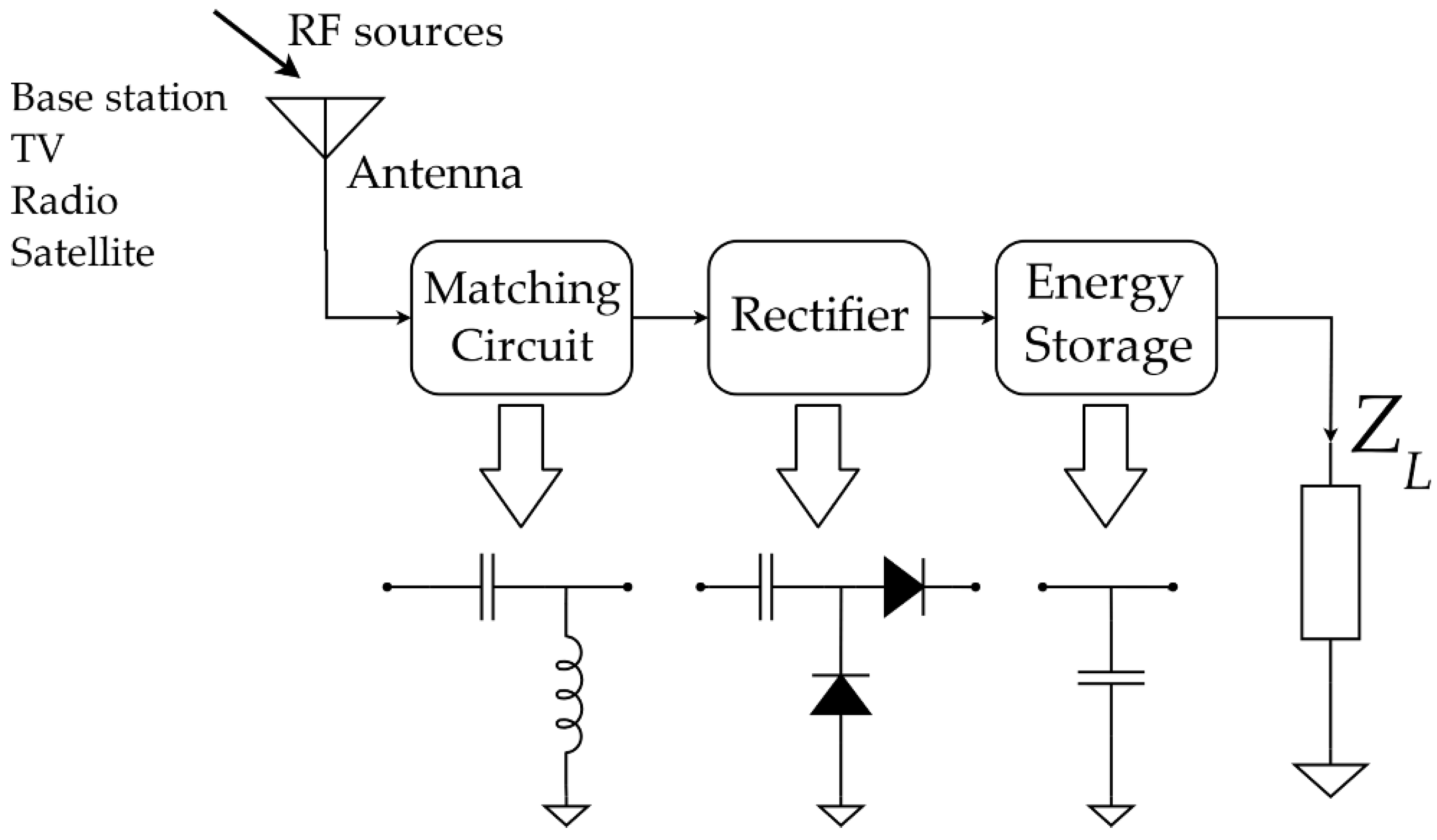
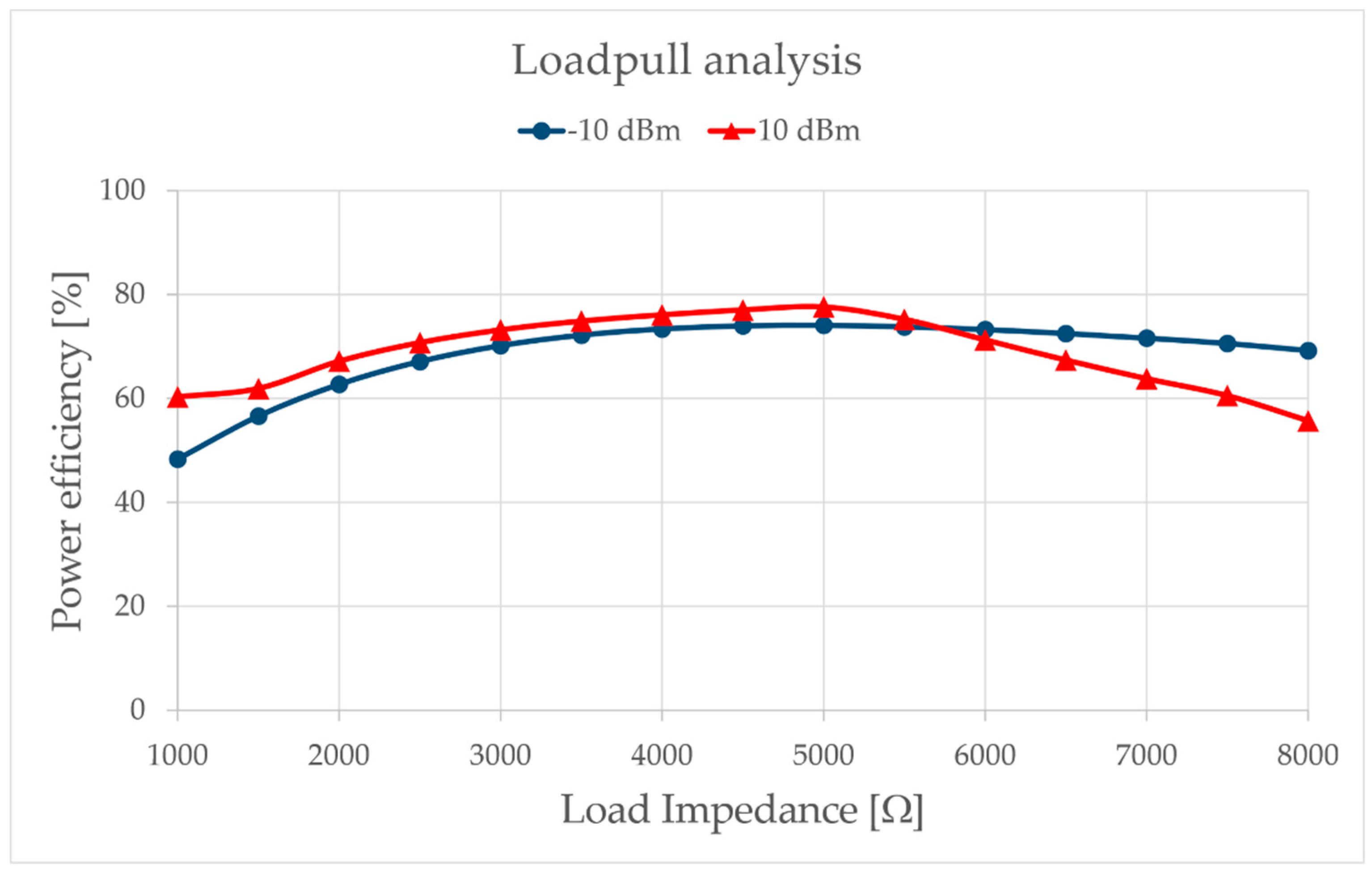

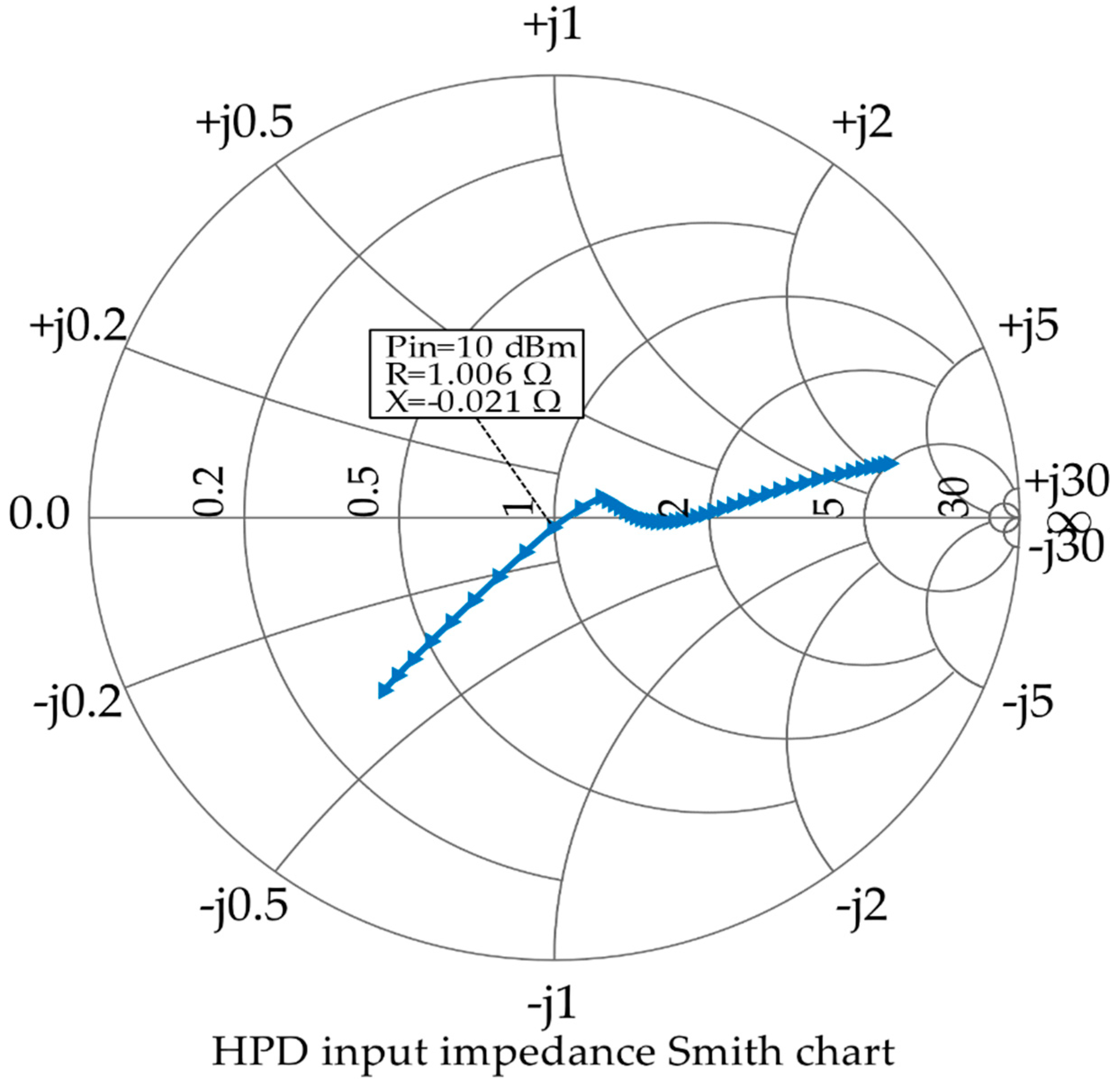
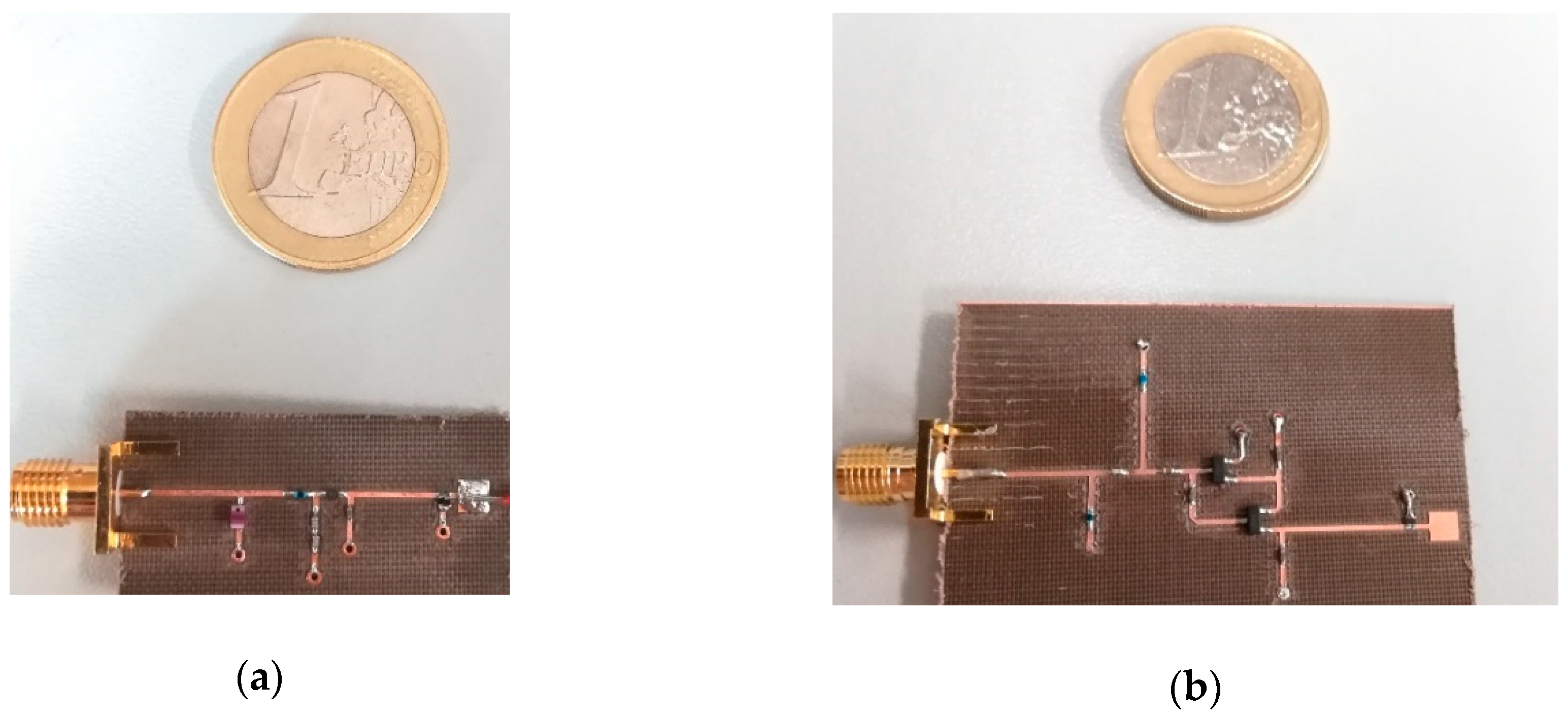
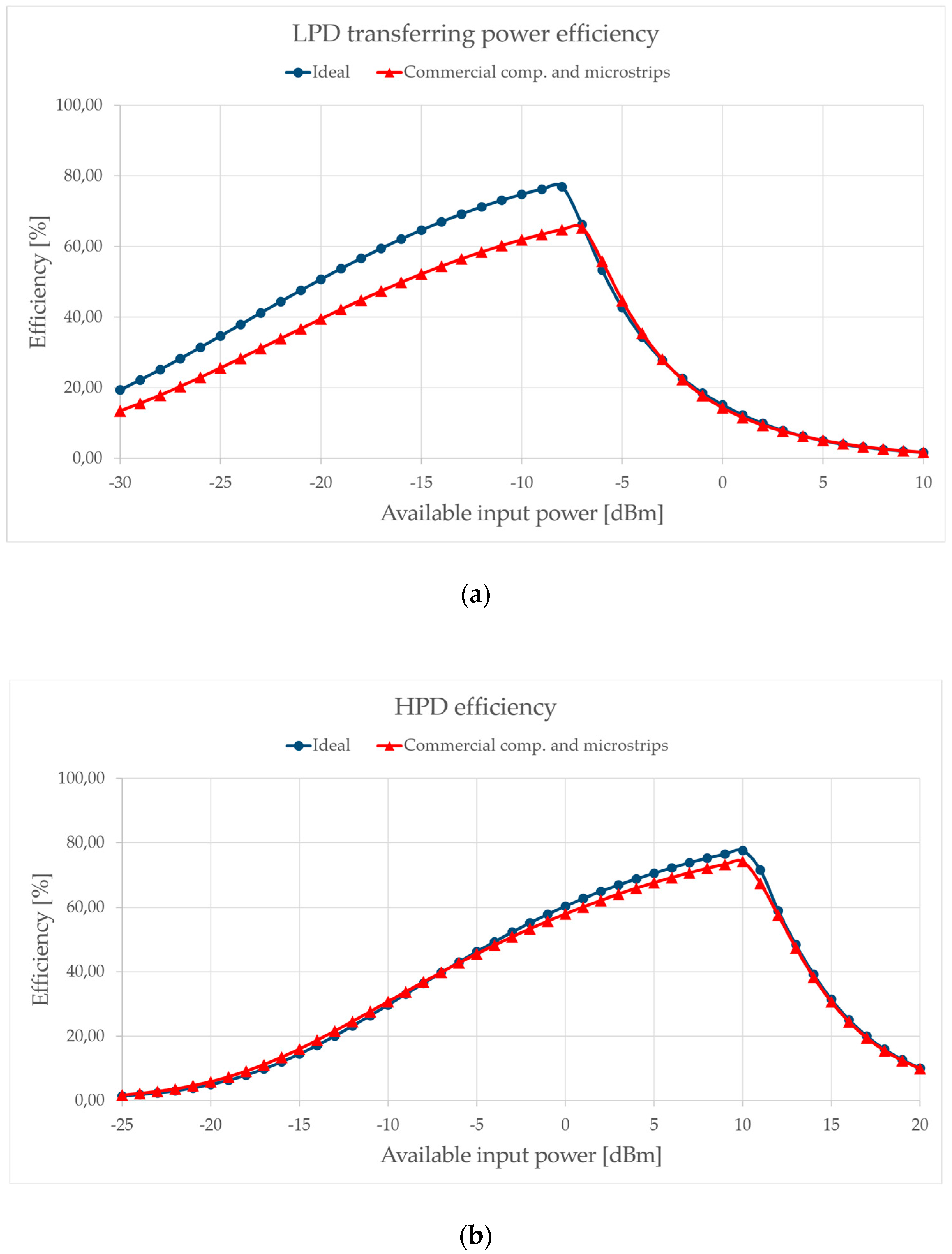
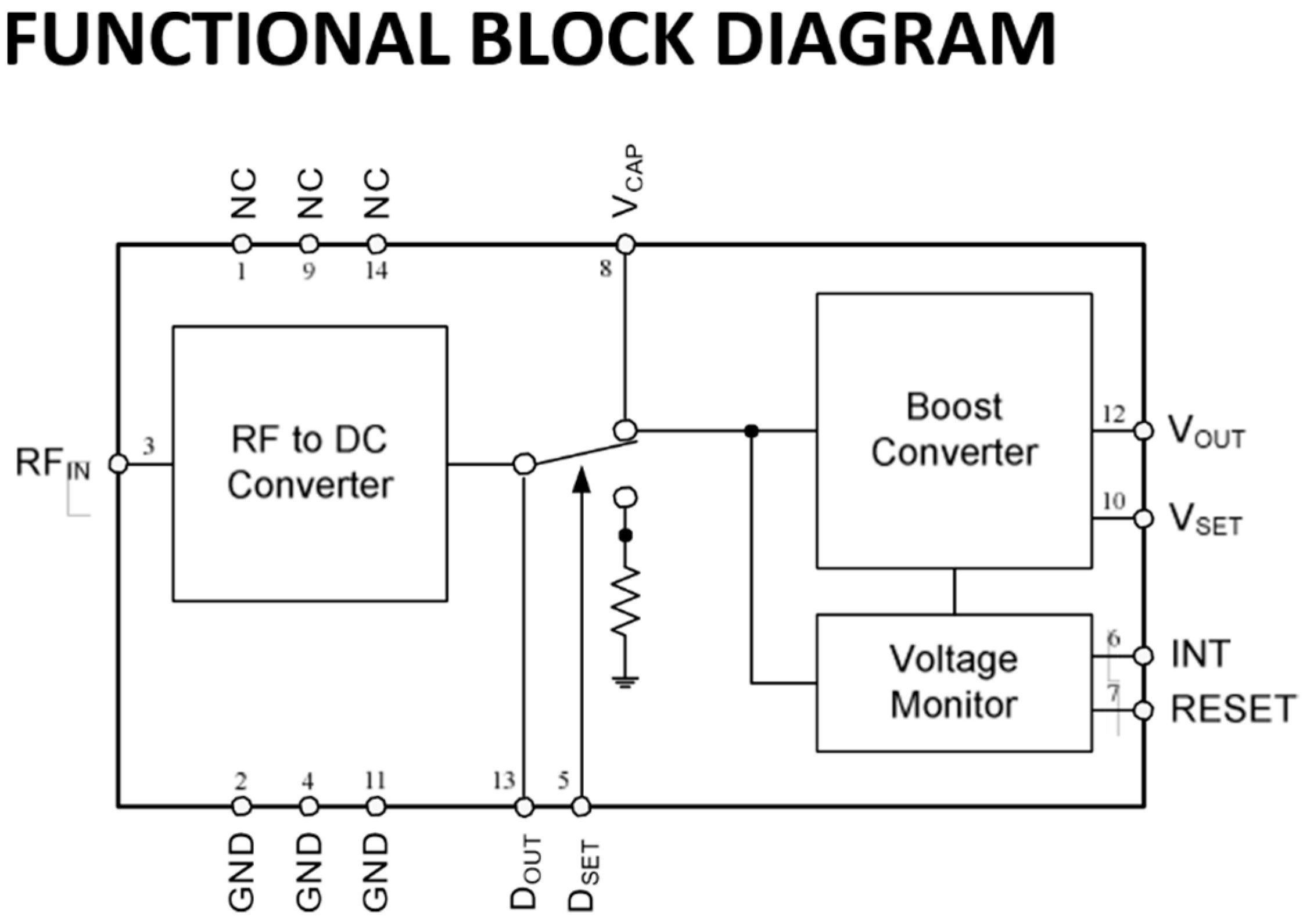
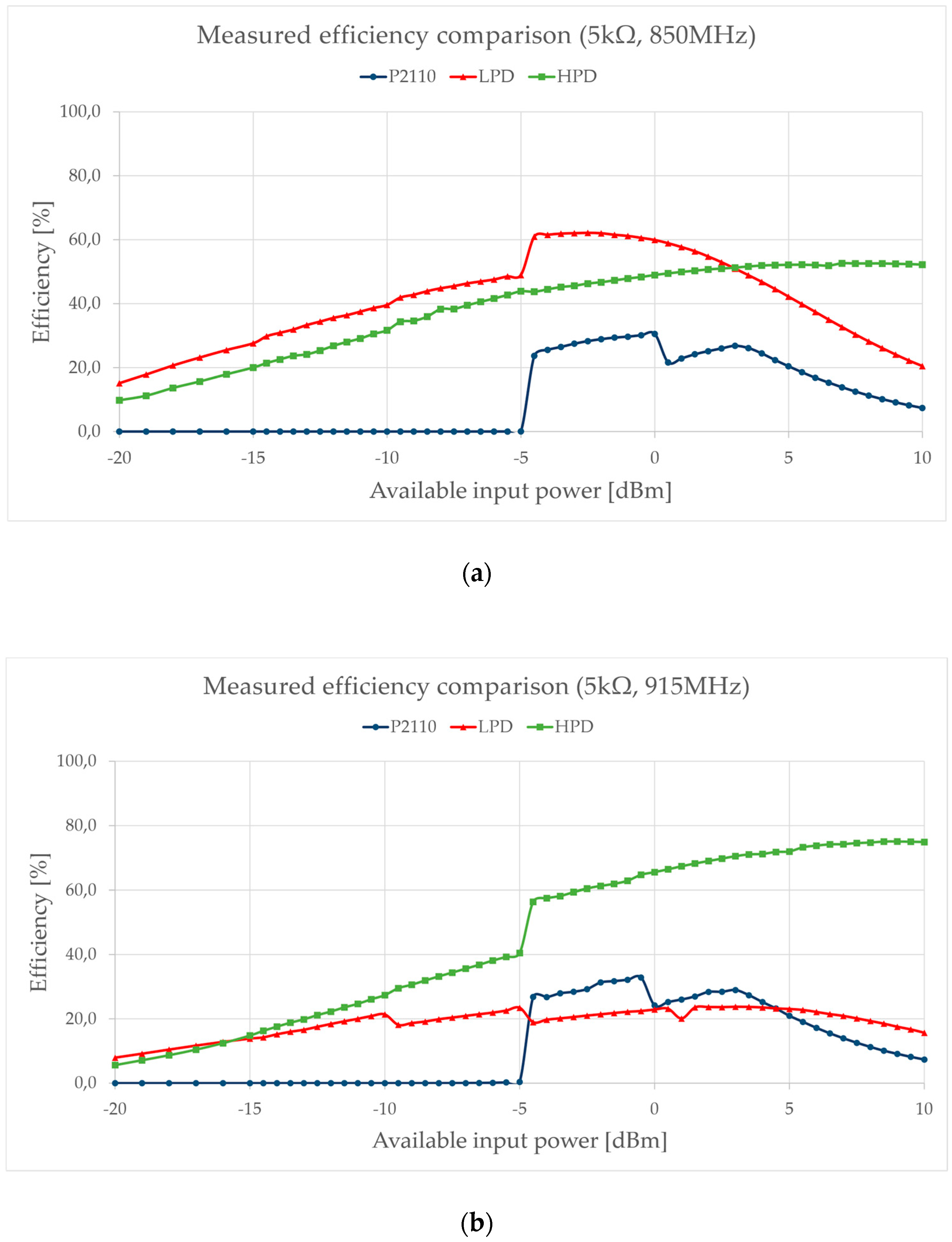

| Component | Value | Model |
|---|---|---|
| L1 | 47 nH | 08CS470 |
| L2 | 56 nH | LQW15AN56NJ00 |
| C1 | 0.3 pF | GJM1555C1HR30WB01 |
| C2 | 0.3 pF | GJM1555C1HR30WB01 |
| Cout | 220 nF | GRM36Y5V224Z10 |
| Component | Value | Model |
|---|---|---|
| L3 | 18 nH | LQW15AN18NH00 |
| L4 | 4.7 nH | LQW15AN4N7C00 |
| C3 | 1.3 pF | GJM1555C1H1R3WB01 |
| Cout | 220 nF | GRM36Y5V224Z10 |
| Distance [m] | P2110 Voltage [V] | HPD Voltage [V] |
|---|---|---|
| 0.25 | 2.040 | 13.450 |
| 0.50 | 1.980 | 9.300 |
| 0.75 | 1.918 | 5.680 |
| 1.00 | 1.892 | 4.680 |
| 1.50 | 1.814 | 2.700 |
| 2.00 | 1.810 | 2.110 |
| 2.50 | 1.830 | 2.770 |
| 3.00 | 1.600 | 1.990 |
| 4.00 | 0.252 | 0.331 |
| 6.80 | 0.720 | 0.900 |
| 8.00 | 0.850 | 0.870 |
| 10.00 | 0.730 | 0.740 |
| 15.00 | 0.134 | 0.256 |
| 20.00 | 0.002 | 0.075 |
| 22.00 | 0.000 | 0.050 |
© 2020 by the authors. Licensee MDPI, Basel, Switzerland. This article is an open access article distributed under the terms and conditions of the Creative Commons Attribution (CC BY) license (http://creativecommons.org/licenses/by/4.0/).
Share and Cite
Colaiuda, D.; Ulisse, I.; Ferri, G. Rectifiers’ Design and Optimization for a Dual-Channel RF Energy Harvester. J. Low Power Electron. Appl. 2020, 10, 11. https://doi.org/10.3390/jlpea10020011
Colaiuda D, Ulisse I, Ferri G. Rectifiers’ Design and Optimization for a Dual-Channel RF Energy Harvester. Journal of Low Power Electronics and Applications. 2020; 10(2):11. https://doi.org/10.3390/jlpea10020011
Chicago/Turabian StyleColaiuda, Davide, Iolanda Ulisse, and Giuseppe Ferri. 2020. "Rectifiers’ Design and Optimization for a Dual-Channel RF Energy Harvester" Journal of Low Power Electronics and Applications 10, no. 2: 11. https://doi.org/10.3390/jlpea10020011
APA StyleColaiuda, D., Ulisse, I., & Ferri, G. (2020). Rectifiers’ Design and Optimization for a Dual-Channel RF Energy Harvester. Journal of Low Power Electronics and Applications, 10(2), 11. https://doi.org/10.3390/jlpea10020011






